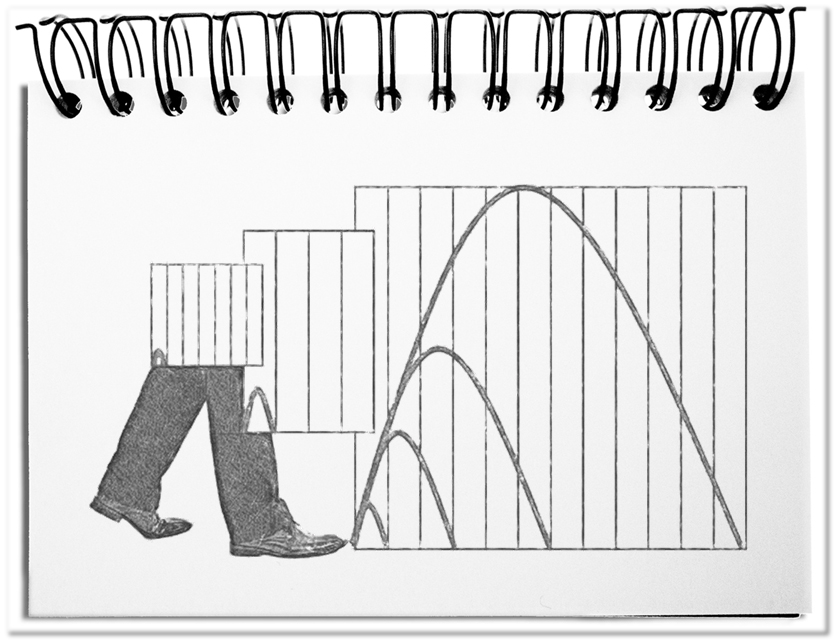Wie viel Veränderung Einem Respekt abverlangt, ist für jeden anders. Es beginnt mit den kleinen Schwankungen, die die verinnerlichte Routine abfälschen. Der Schreibtisch, den jemand aufgeräumt hat. Der tägliche Weg zur Arbeit, der durch eine Baustelle versperrt ist. Es sind die Modifikationen, die vertraute Gewohnheiten verunmöglichen. Die Einführung eines neuen IT-Systems oder die Neuverteilung der Aufgaben, die ein anderes Vorgehen erfordern, weil die alten nicht mehr gültig sind. Und dann gibt es noch die grundsätzlichen Umwälzungen, die alle Aspekte des Lebens betreffen. Der Ausstieg aus dem aktuellen Leben, wenn man auswandert oder seinen bisherigen Berufsweg verlässt. Unabhängig davon, wie stark die Umwälzungen sind, müssen alle mit einem eigenen Rhythmus auf den Wandel reagieren.
Da der Wandel einen unentwegt mit unterschiedlicher Stärke fordert, ist es hilfreich eine Routine zu entwickeln, die das Momentum der Veränderung so lange erhält, bis man sich an die neue Routine gewöhnt hat. Dabei kann man die folgenden Ansätze nutzen und jeweils mit etwas Besonderem zelebrieren.
- Der erste Schritt
Die Veränderung beginnt erst, wenn man sich tatsächlich in Bewegung setzt. Dabei ist der erste Schritt hin zu dem Neuen entscheidend, um den Wandel zu starten. Auch wenn dieser erste Schritt klein und unbedeutend erscheint, ist dieser Quantensprung der Anfang, egal wie lang der Weg ist. - Der erste Tag
Es ist sinnvoll den ersten Tag zu feiern, den man nach dem ersten Schritt hinter sich gebracht hat. Nicht die Flinte ins Korn geworfen zu haben, macht den ersten Tag zu einem wichtigen Fortschritt in Richtung Veränderung. Bemerkt man dann bereits erste Ergebnisse, ist die Fortsetzung am folgenden Tag sichergestellt. - Die erste Woche
Nach einer Woche zeigen sich die ersten Anzeichen der neuen Routine. Das Neue ist jetzt bereits mehrfach angewendet, auch wenn es noch nicht in Fleisch um Blut übergegangen ist. Die Tücke liegt im Detail, das in der Folge erkannt und bewältigt wird. - Der erste Monat
Je nach dem Umfang sind nach einem Monat bereits viele Aspekte der Änderung bekannt. Die Hürden des ersten Tages sind vergessen. Es ist viel eingeübt, was daran erkennbar wird, dass man die erlangten Fähigkeiten gar nicht mehr bewusst wahrnimmt. - Das erste Quartal
Nach drei Monaten befindet man sich bereits im alltäglichen Fluss. Die Aufgaben werden routiniert ausgeführt. Die Folgerichtigkeit früherer Vorgehen wird abgelöst von den neuen Fertigkeiten und Schlüssen, die einem jetzt zur Verfügung stehen. - Das erste Halbjahr
Nach einem halben Jahr ist man vollständig eingearbeitet. Die eigenen Werte und Überzeugungen wurden angepasst. Die Überraschungen, die jetzt aus dem Nichts erscheinen, finden sowieso statt, egal wie eingeübt man ist. Vergangene Ansätze fallen einem schwer, da man sich gar nicht mehr in das Alte hineindenken kann. - Das erste Jahr
Nach einem Jahr sind die Erinnerungen ans Alte verblasst. Alte Vorgänge lassen sich nur noch schwer rekonstruieren. Die Erinnerungen daran erzeugen ein ungutes Gefühl, da sich das Neue bewährt hat. Am Horizont ist bereits der nächste Wandel erkennbar.
Jeder hat seine ganz persönliche Herangehensweise an Umgestaltungen. Dies reicht von bloß nichts anders machen, bis hin zu jede Veränderung ist willkommen. Die Rituale, die man sich einfallen lässt, um die Veränderung zu verkraften, bestimmen die Schwierigkeiten, mit denen man umgehen muss. Da der Wandel vor allem im Kopf stattfindet, reicht es umzudenken. Schafft man das nicht, dann kostet die Umstellung mehr Kraft, als wenn man das Neue offen annimmt.
Fazit: Die Umsetzung von Veränderungen stößt von Natur aus auf Widerstand. Vor allem, wenn die Betroffenen keine Gelegenheit haben, sich mental darauf einzulassen. Für die einzelnen Betroffenen ist es hilfreich, die Metamorphose zu feiern. Und zwar nicht nur einmal, sondern immer wieder. Um die Neuerungen in dem eigenen Kopf ansprechend zu verankern, findet man am besten seinen Rhythmus: der erste Schritt; der erste Tag; die erste Woche; der erste Monat; das erste Quartal, das erste Halbjahr; das erste Jahr. Über die Zeit werden Abweichungen zum Normalzustand.

